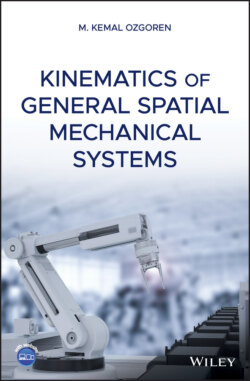Читать книгу Kinematics of General Spatial Mechanical Systems - M. Kemal Ozgoren - Страница 19
1.3.2 Cross Product
ОглавлениеThe cross product (a.k.a. vector product) of two vectors and is denoted and defined as follows:
(1.15)
In Eq. (1.15), as defined before, θpq is the angle measured from to . As for , it is defined as a unit vector, which is perpendicular to the plane formed by the vectors and .
If and are skew (nonparallel) vectors, then is formed by imagining that and are translated toward each other until they are connected tail‐to‐tail. If and are parallel (but not coincident) vectors, then happens to be the plane that contains them. However, if and are coincident vectors, then cannot be formed as a definite plane, i.e. it can be any plane that contains them.
The sense of is defined conventionally by the right‐hand rule. This rule is based on the right hand in such a way that assumes the orientation of the thumb (directed from root to tip) while the fingers are oriented from to .
Since, by definition, and , the following equations can be written for the vectors involved in the cross product.
(1.16)
(1.17)
If sin θpq = 0, i.e. if with θpq = 0 or with θpq = π, then
(1.18)
If the order of and is reversed, Eq. (1.15) becomes
(1.19)
According to Eq. (1.12), θqp = θpq. However, according to the right‐hand rule,
(1.20)
Therefore, . This verifies the well‐known characteristic feature of the cross product that its outcome changes sign when the order of its multiplicands is reversed. That is,
(1.21)
